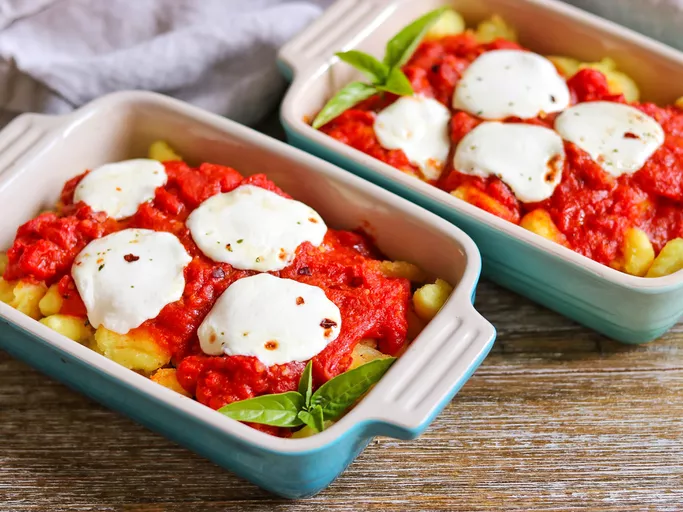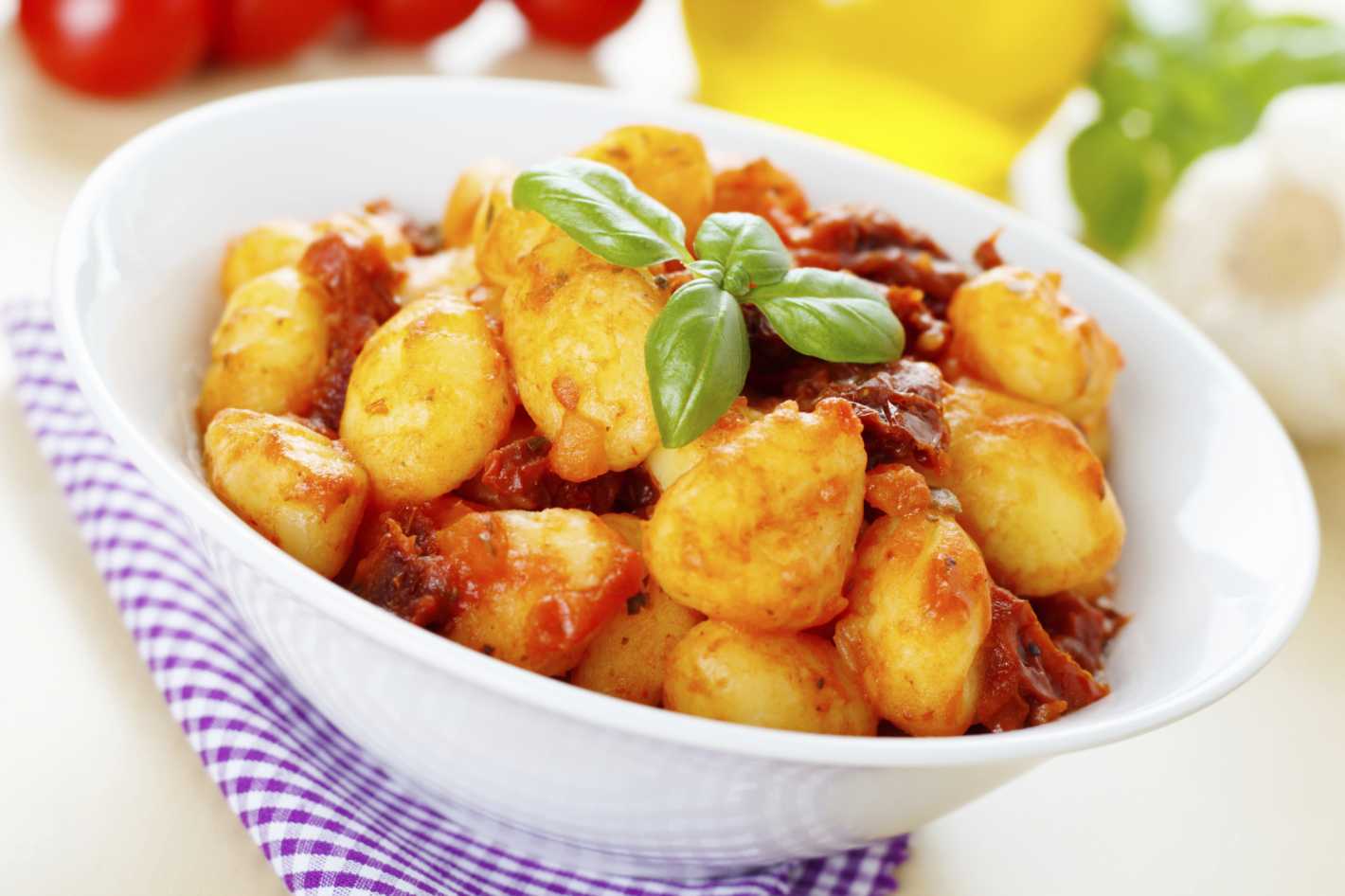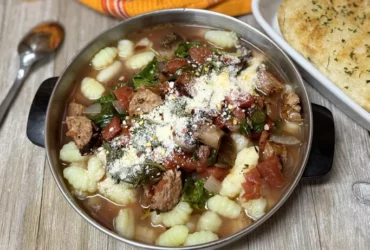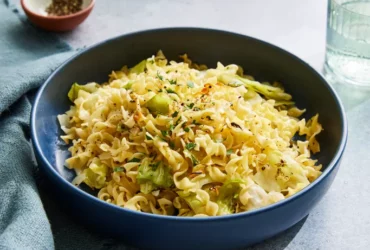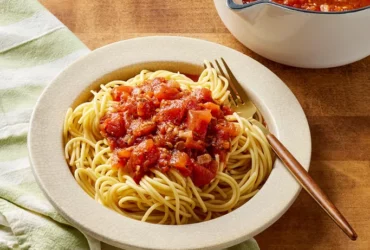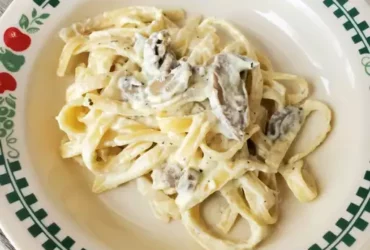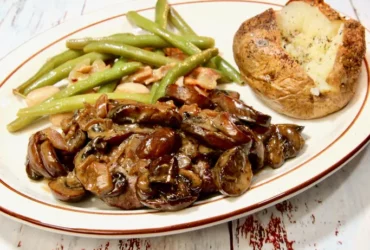Ingredients
Gnocchi
Gnocchi is a type of Italian pasta that originates from the region of Piedmont. The name “gnocchi” comes from the Italian word for “lump” or “knot,” which refers to the dumpling-like shape of these small, soft noodles.
Traditionally, gnocchi are made from potatoes, flour, and eggs. The potatoes are boiled and then mashed to create a smooth, thick paste called “purée.” This purée is mixed with all-purpose flour and eggs to form a dough that can be kneaded and shaped into small dumplings.
The most common ingredient in gnocchi is the potato, which provides a light and fluffy texture. The type of potato used can affect the taste and texture of the gnocchi. For example, high-starch potatoes like Russet or Idaho work well for making gnocchi because they yield a light, airy texture.
Other ingredients that may be added to the dough to give it more flavor and texture include Parmesan cheese, nutmeg, and salt. The amount of each ingredient used can vary depending on personal preference and the type of dish being made.
Gnocchi can also be flavored with various herbs and spices, such as basil or oregano, which complement their mild potato taste. Some recipes may call for adding vegetables like garlic or onion to the dough for added flavor.
Some variations of gnocchi use semolina flour instead of all-purpose flour. Semolina is a coarse, yellowish flour made from durum wheat that gives gnocchi a slightly crunchy texture and nutty flavor.
The quality of the ingredients used in gnocchi can greatly affect its taste and texture. Fresh, high-quality potatoes will yield lighter, fluffier gnocchi than old or low-quality potatoes.
1 cup all purpose flour
- All-purpose flour is a staple ingredient used in many Italian recipes, including the traditional Gnocchi with Pomodoro Sauce.
- In the context of this recipe, all-purpose flour is used to make the gnocchi dough, which requires 1 cup or approximately 120 grams of flour per serving.
Why All-Purpose Flour?
All-purpose flour is a versatile and widely available type of flour that can be used in various baked goods and pasta recipes. It has a neutral flavor and a relatively soft texture, making it ideal for creating tender gnocchi.
The protein content in all-purpose flour helps to create structure and elasticity in the dough, while the starch provides moisture retention and helps the gnocchi cook evenly.
Characteristics of All-Purpose Flour
- Protein Content: Typically ranges from 9-12% protein by weight
- Gluten Strength: Medium to strong gluten strength allows for good elasticity in the dough
- Moisture Absorption: Relatively high moisture absorption capacity helps retain moisture in the gnocchi
All-purpose flour can vary slightly depending on the brand or region, but its general characteristics make it suitable for most recipes.
Choosing the Right Flour for Gnocchi
When selecting a type of flour for making gnocchi, it’s essential to consider the specific needs and requirements of your recipe.
All-purpose flour is an excellent choice because it provides a balance of protein content, gluten strength, and moisture absorption. However, you can also experiment with other types of flour if you want to create unique variations in texture or flavor.
Alternative Flour Options
- Cake Flour: Soft wheat cake flour can result in tender gnocchi with a delicate texture. However, it may not hold its shape as well as all-purpose flour.
- Pancake Mix Flour: Some pancake mix flours are designed to produce soft and fluffy baked goods, which could translate to lighter gnocchi. Keep in mind that the results might be more unpredictable than using all-purpose flour.
- Whole wheat flour offers a nuttier flavor and coarser texture compared to refined all-purpose flour. It can produce heartier gnocchi with a more robust taste, but it may require adjustments to the liquid content in the dough.
Feel free to experiment with different types of flour to find your preferred combination for making delicious homemade gnocchi!
1/4 teaspoon salt
To make this delicious Gnocchi with Pomodoro Sauce, you’ll need the following ingredients:
- Gnocchi
For the gnocchi dough:
You will need the following:
- 1 large potato, peeled
- 1/4 teaspoon salt
- 1 tablespoon all-purpose flour
- 1 egg, lightly beaten
- 1 tablespoon extra-virgin olive oil
For the Pomodoro Sauce:
You will need the following:
- 2 tablespoons olive oil
- 4 garlic cloves, minced
- 1 can (28 oz) crushed tomatoes
- 1/4 cup chopped fresh basil
- Salt and freshly ground black pepper to taste
Additional ingredients:
You may also need the following:
- Grated Parmesan cheese, for serving (optional)
- Fresh parsley, chopped (for garnish)
1 egg
When it comes to making gnocchi, one of the most essential ingredients is a single egg.
The egg serves several purposes in this recipe, and its inclusion can make or break the texture and flavor of your finished dish.
Here are some key things to consider when working with eggs in your gnocchi:
Egg size
The size of the egg is important when making gnocchi. A large egg will generally yield more volume than a small one, which can affect the overall texture and consistency of your gnocchi.
Room temperature egg
It’s essential to use a room temperature egg for making gnocchi. This ensures that the eggs mix smoothly with the other ingredients and helps prevent any lumps from forming in the dough.
Egg yolk ratio
The amount of egg yolk used can greatly impact the color, texture, and flavor of your gnocchi. In general, it’s best to use a small amount of egg yolk relative to the other ingredients to achieve a light, fluffy texture.
When using an egg in this recipe, be sure to mix it thoroughly with the other ingredients and handle the dough gently to avoid overworking it. This will help you achieve a smooth, even texture that’s perfect for gnocchi.
By incorporating one large room temperature egg into your gnocchi dough, you’ll create a light and fluffy texture that pairs beautifully with the rich flavors of the Pomodoro sauce.
1 tablespoon unsalted butter, melted
The first step in preparing this classic Italian dish, Gnocchi with Pomodoro Sauce, involves acquiring and preparing various ingredients. The key ingredient in question is melted butter which serves a crucial function in bringing out the flavors of the dish.
To start, we require 1 tablespoon of unsalted butter to be melted. It’s essential to note that the use of unsalted butter allows us to have more control over the flavor profile of our dish. We want the taste to be rich and creamy without being overwhelmed by excessive saltiness.
The next step is to melt this butter in a pan. You can do this by placing the pan on low heat or by using a double boiler method if you’re concerned about burning the butter. Once it’s melted, it will be ready to use in conjunction with our other ingredients.
In terms of the quantity required, 1 tablespoon is usually sufficient for most recipes. However, this can vary depending on your personal preferences and the specific requirements of your dish. If you find that you need more or less melted butter, you should adjust accordingly.
To sum up, when it comes to incorporating melted butter into our recipe, we want to focus on using high-quality unsalted butter and a sufficient quantity to achieve the desired flavor profile. This will ensure that our Gnocchi with Pomodoro Sauce is rich, creamy, and full of flavor.
Instructions
Cooking the Gnocchi
To cook the gnocchi according to this recipe, follow these steps:
Step 1: Bring a Large Pot of Water to a Boil
Fill a large pot with salted water and bring it to a boil over high heat. The amount of salt needed is about 1 tablespoon for every 4 cups of water.
Step 2: Add the Gnocchi to the Water
Once the water has reached a rolling boil, gently add the gnocchi to the pot in batches if necessary, being careful not to overcrowd the pot. The cooking time will depend on the type and brand of gnocchi you are using, but typically it’s around 3-5 minutes for fresh gnocchi or 1-2 minutes for frozen.
Step 3: Check for Doneness
Use a slotted spoon to remove one or two gnocchi from the water and test them for doneness. The cooked gnocchi should be slightly resistant in the center but yield to pressure when pressed with your finger or the back of the spoon.
Step 4: Drain and Serve
Using a slotted spoon, carefully transfer the cooked gnocchi from the pot to a colander. Remove as much water as possible by gently shaking the colander. Then, transfer the drained gnocchi to a plate or individual plates, depending on your serving style.
Tips and Variations
- Add some chopped fresh herbs, like parsley or basil, to the gnocchi for extra flavor.
- For a richer sauce, use a combination of grated Parmesan cheese and tomato paste in your Pomodoro Sauce.
- To make this dish more substantial, add cooked chicken, sautéed vegetables, or toasted pine nuts on top of the gnocchi and sauce.
Bring a large pot of salted water to a boil and cook the gnocchi for 35 minutes or until they float to the surface.
To achieve the perfect Gnocchi dish, it’s essential to follow a set of precise instructions that will guide you through the cooking process.
The first step involves bringing a large pot of salted water to a rolling boil. The use of salt in the water is crucial as it helps to season the Gnocchi and also adds flavor to the dish.
Once the water has reached its boiling point, carefully add the Gnocchi to the pot. Be sure to cook them for exactly 35 minutes or until they start to float to the surface of the water.
This is a crucial step in the cooking process, as it indicates that the Gnocchi are cooked through and ready to be served. It’s essential not to overcook or undercook the Gnocchi, as this can result in a dish that’s either mushy or still raw.
While the Gnocchi is cooking, you can start preparing the Pomodoro Sauce by sautéing garlic and onions until they’re softened. This will form the base of the sauce, which will add a rich and tangy flavor to the dish.
Once the Gnocchi is cooked, carefully drain it in a colander and return it to the pot with the Pomodoro Sauce. Toss everything together until the Gnocchi is well coated in the sauce, then serve immediately.
This simple yet delicious recipe for Gnocchi with Pomodoro Sauce requires attention to detail and a clear understanding of the cooking process. By following these instructions carefully, you’ll be able to create a dish that’s both flavorful and visually appealing.
Reserve 1 cup of pasta water before draining the gnocchi.
Instructions for cooking Gnocchi with Pomodoro Sauce typically involve several steps that require attention to detail and careful planning. One important step, however, is often overlooked by home cooks: reserving a portion of pasta water before draining the gnocchi.
Reserving 1 cup of pasta water before draining the gnocchi is a crucial step in this recipe. Pasta water contains starches that have been released from the pasta during cooking, which can help to create a smooth and creamy sauce when combined with the right ingredients.
In the context of Gnocchi with Pomodoro Sauce, reserving pasta water serves several purposes. First, it allows the cook to adjust the consistency of the sauce by adding more or less water as needed. This is particularly important in this recipe, where a thick and rich sauce is desired but may not be achievable with just the tomato paste and olive oil.
Secondly, pasta water helps to emulsify the sauce, meaning that it combines the ingredients in a smooth and stable mixture. When pasta water is added to the sauce, it can help to break down the starches in the tomato paste and create a more even consistency throughout the dish.
Finally, reserving pasta water provides an opportunity for cooks to add extra flavor to the sauce if desired. By adding some of this reserved water to the sauce, cooks can enhance its overall taste and aroma without sacrificing any texture or consistency.
To make the most of this step in cooking Gnocchi with Pomodoro Sauce, it’s essential to reserve at least 1 cup of pasta water from the gnocchi. This amount may seem excessive, but trust that it will be needed later on when combining all the ingredients for the final sauce.
Keep in mind that this reserved pasta water should not be discarded; instead, store it in a separate container or bowl and set it aside until later use. By doing so, home cooks can avoid mistakes like wasting valuable pasta water that’s essential to their recipe’s success.
Pomodoro Sauce
Making the Sauce
The key to a great Pomodoro Sauce lies in its simplicity and the quality of ingredients used. This classic Italian sauce is made from just a few ingredients, including canned crushed tomatoes, garlic, olive oil, salt, and sometimes red pepper flakes for added heat.
To make Pomodoro Sauce, start by peeling and finely chopping 3-4 cloves of garlic. You can use more or less garlic depending on your personal preference, but 3-4 cloves is a good starting point for most recipes.
Heat 2 tablespoons of olive oil in a large saucepan over medium-low heat. Once the oil is warm, add the chopped garlic and sauté for about 1 minute, or until fragrant. Be careful not to burn the garlic – it should be lightly toasted but still soft and aromatic.
Next, add 2 cups of canned crushed tomatoes to the saucepan. You can use fresh tomatoes if they’re in season, but canned tomatoes are a more convenient and reliable option for most people.
Add salt to taste to the saucepan – about 1/4 teaspoon is a good starting point. You can always add more salt later, but it’s harder to remove excess salt from the sauce.
If you like a bit of heat in your Pomodoro Sauce, now is the time to add red pepper flakes. Start with just 1/4 teaspoon and taste as you go – you can always add more heat but it’s harder to remove it once it’s added.
Simmer the sauce over low heat for about 10-15 minutes, stirring occasionally. This will allow the flavors to meld together and the sauce to thicken slightly. You can help the process by mashing the tomatoes with a potato masher or the back of a spoon.
Taste and adjust the seasoning as needed. If the sauce needs more salt, add it in small increments until you’re happy with the flavor. If you prefer a smoother sauce, you can blend it in a blender or food processor – but be careful not to over-process, as this can make the sauce too thin.
That’s it! Your Pomodoro Sauce is now ready to use in your Gnocchi recipe. You can store any leftover sauce in an airtight container in the fridge for up to 3 days or freeze it for later use.
In a saucepan, heat 2 tablespoons of olive oil over medium low heat and sauté 34 garlic cloves until fragrant.
Pomodoro sauce, a classic Italian condiment originating from Naples, is a fundamental component of many traditional dishes, particularly when paired with delicate gnocchi. The sauce’s simplicity and versatility have made it a staple in Italian cuisine for generations. At its core, Pomodoro sauce is essentially a tomato-based sauce, characterized by its vibrant red color and rich flavor.
The traditional recipe for Pomodoro sauce begins with the sautéing of garlic cloves in olive oil over medium-low heat. This step not only infuses the oil with the aromatic properties of the garlic but also creates a fragrance that forms the foundation of the sauce’s flavor profile. In many recipes, including our Gnocchi with Pomodoro Sauce Recipe, 2-3 garlic cloves are typically used for this purpose, though some may prefer the added depth brought by more garlic. It is worth noting that when using as many as 34 garlic cloves as mentioned in your initial instruction, a different flavor dynamic would be achieved, potentially overpowering the delicate taste of gnocchi.
The sautéed garlic and oil mixture then forms the base for adding canned or fresh tomatoes, along with other optional ingredients such as onions, bell peppers, salt, and basil. The choice between using canned crushed tomatoes or fresh tomatoes can significantly alter the texture and flavor of the sauce. Canned tomatoes are often preferred due to their uniform consistency and rich flavor, while fresh tomatoes offer a more vibrant taste and the opportunity for added layers of flavor.
Regardless of the chosen ingredients, the key to achieving a great Pomodoro sauce lies in its balanced flavors and smooth texture. Cooking the sauce over low-medium heat for about 15-20 minutes allows it to simmer gently, infusing all the flavors together harmoniously. Some recipes may also include adding sugar or red wine to balance out the acidity of the tomatoes.
The resulting Pomodoro sauce is a blend of sweet and tangy that perfectly complements the tender gnocchi in our featured recipe. This pairing exemplifies how the simplicity and elegance of Italian cuisine can create unforgettable dining experiences for those who enjoy authentic flavors and traditional cooking methods.
Add 2 cups of crushed San Marzano tomatoes, 1 teaspoon of dried oregano, and salt and pepper to taste. Simmer the sauce for 1520 minutes, stirring occasionally.
The Pomodoro Sauce is a classic Italian condiment that originated in the Campania region, particularly in Naples. It’s a fundamental component in many Italian dishes, including pasta, pizza, and yes, even gnocchi! The word “Pomodoro” literally translates to tomato in English.
This sauce is made with an abundance of fresh tomatoes, which are crushed to release their natural flavors and oils. In this recipe, we’ll be using 2 cups of crushed San Marzano tomatoes, a variety known for its sweet and low-acidity flavor profile. These tomatoes are the hallmark of authentic Italian sauces.
The addition of 1 teaspoon of dried oregano adds a subtle earthy depth to the sauce, which complements the bold flavor of the tomatoes perfectly. You can adjust the amount of oregano to your taste, but keep in mind that it’s a delicate herb and should be used sparingly.
To season the sauce, simply sprinkle some salt and pepper to taste. This is where you get to add a personal touch to the sauce, so don’t be shy! The key is to balance the flavors without overpowering them.
Now it’s time to simmer the sauce for 15-20 minutes, stirring occasionally. During this time, the flavors will meld together, and the sauce will thicken slightly. Don’t worry if you need a bit more time – just keep an eye on it and stir every now and then to prevent scorching.
And that’s it! Your homemade Pomodoro Sauce is ready to be paired with your favorite pasta, pizza, or in this case, delicious gnocchi. Buon appetito!
Stir in 1 tablespoon of chopped fresh basil and 1 tablespoon of grated Parmesan cheese.
Pomodoro sauce, a staple of Italian cuisine, originates from Italy and is typically made with San Marzano tomatoes, which are sweeter and less acidic than other varieties. The name “Pomodoro” literally translates to “tomato” in Italian, and this sauce is often referred to as “salsa pomodoro” or simply “tomato sauce.” However, its rich flavor profile and versatility make it more deserving of the title “sauce.”
The recipe calls for a combination of ingredients, including 1 can of whole peeled tomatoes (28 ounces), 4 garlic cloves (minced), 2 tablespoons of extra-virgin olive oil, salt, and black pepper. These components come together to create a sauce that is both flavorful and nutritious.
The cooking process begins by heating the olive oil in a large skillet over medium heat. Next, the minced garlic is added and sautéed for about 1 minute until fragrant. The garlic is then removed from the pan, leaving behind a subtle aroma that enhances the overall flavor of the sauce.
Now, it’s time to add the canned tomatoes, salt, and black pepper to the skillet. Stir everything together well, ensuring the flavors are evenly distributed throughout the mixture. Let the sauce simmer for 15-20 minutes, allowing the flavors to meld together and the liquid to reduce slightly.
A key component of this recipe is the addition of fresh basil and Parmesan cheese. Just before serving, . This will not only enhance the flavor of the sauce but also add a delightful aroma to your dish.
In many traditional Italian recipes, such as Gnocchi with Pomodoro Sauce, the sauce is served over cooked gnocchi. However, feel free to pair it with other pasta varieties or use it as a dipping sauce for breadsticks or croutons. The possibilities are endless!
Combine cooked gnocchi and sauce, adding some reserved pasta water if needed, and serve immediately.
The final step in preparing delicious Gnocchi with Pomodoro Sauce is to combine cooked gnocchi and sauce, adding some reserved pasta water if needed, and serve immediately.
To begin, gently add the cooked gnocchi to the Pomodoro Sauce, making sure not to break them apart. The Pomodoro Sauce is made with crushed San Marzano Tomatoes, garlic, olive oil, and herbs like basil.
If the sauce seems too thick, you can add a little reserved pasta water to thin it out. This will help prevent the sauce from becoming too sticky or overpowering.
Once you’ve combined the gnocchi and Pomodoro Sauce, serve immediately. You can garnish with some extra basil leaves or grated Parmesan cheese for added flavor and texture.
The key to a great Gnocchi with Pomodoro Sauce is using high-quality ingredients, like fresh tomatoes and good quality olive oil. By following these simple steps and using the right ingredients, you can create a delicious and satisfying meal that’s sure to please even the pickiest eaters.
Remember, Pomodoro Sauce is a versatile sauce that can be used with many types of pasta, so feel free to experiment and find your favorite pairings. And don’t forget to reserve some pasta water before draining the gnocchi – it’s essential for achieving the right consistency in the final dish.
With its bright red color and tangy flavor, Pomodoro Sauce is a classic Italian sauce that’s perfect for spring and summer dishes. And when combined with tender gnocchi, it creates a match made in heaven – a delicious Gnocchi with Pomodoro Sauce recipe that’s sure to become a staple in your kitchen.
In short, combining cooked gnocchi and Pomodoro Sauce, adding some reserved pasta water if needed, and serving immediately will yield a dish that’s both flavorful and visually appealing. So go ahead and give it a try – your taste buds will thank you!
- Best Dun & Bradstreet (DNB) Alternatives for 2025 - April 24, 2025
- Best Seamless.ai Alternatives for 2025 - April 22, 2025
- Best Coldlytics Alternatives for 2025 - April 22, 2025

